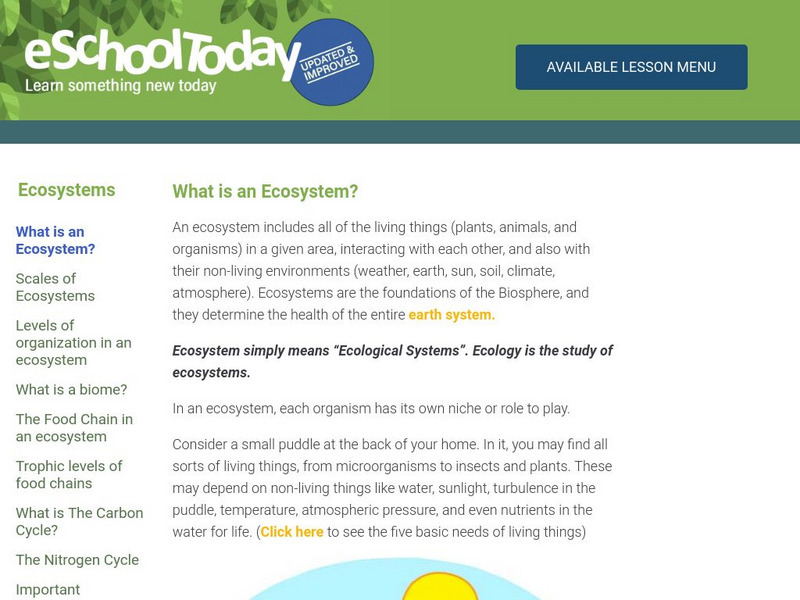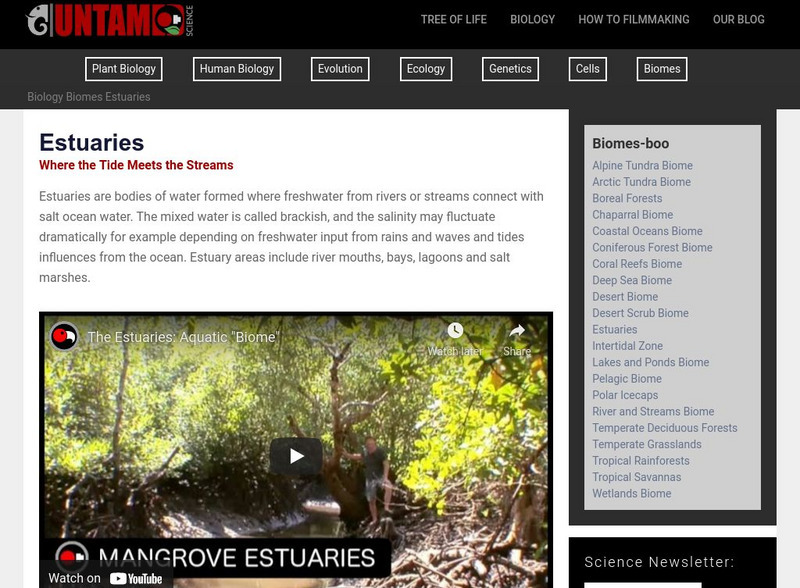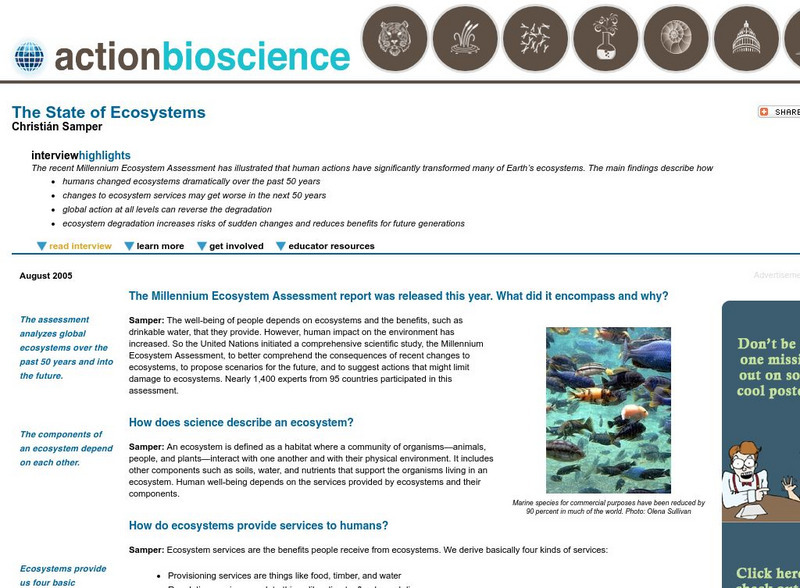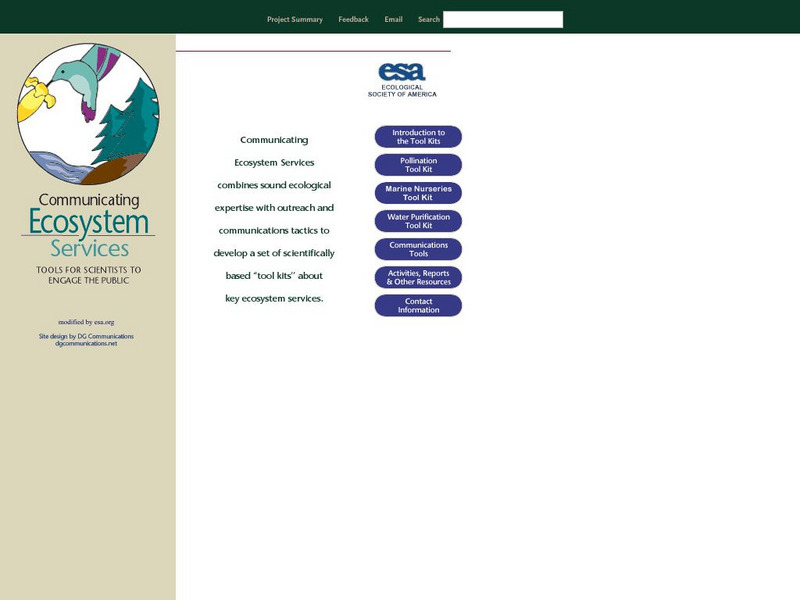eSchool Today
E School Today: What Is an Ecosystem?
Learn about all the different levels of ecosystems, from the living things under a rock, up to a rainforest biome. Explains the levels of organization within an ecosystem, the different types of biomes, food chains and trophic levels,...
Enchanted Learning
Enchanted Learning: Biomes
Discover the hidden treasures in the different habitats on the earth! The earth is filled with many biomes. Examples of different biomes are listed and include hyperlinks to additional information such as the animals found there.
PBS
Pbs Learning Media: Biomes
This interactive resource adapted from NASA describes the different temperature, precipitation, and vegetation patterns in seven biomes: coniferous forest, temperate deciduous forest, desert, grassland, rainforest, shrubland, and tundra.
Untamed Science
Untamed Science: Biology: World Biomes: Estuaries Biome
Make learning about Earth's biomes fun and easy with video clips, photographs, and diagrams. Learn about estuaries, the water environments formed where freshwater from rivers or streams mix salt ocean water. [6:38]
The Wild Classroom
The Wild Classroom: Biomes of the World: Temperate Grasslands Biome
Learn all about the Temperate Grasslands biome. Find out about plants, animals, adaptations, and conservation efforts.
Other
Introduction to the Biosphere: Characteristics of the Earth's Terrestrial Biomes
From Chapter 9 of a textbook on physical geography that covers the biosphere. Important vocabulary is highlighted and linked to a glossary. It explains the characteristics of a biome, and describes the features of the eight different...
American Institute of Biological Sciences
Action Bioscience: The State of Ecosystems
Christian Samper details The Millennium Ecosystem Assessment, a report highlighting the detrimental impact of human life on the ecosystems of Earth over the past fifty years. Ecosystems have been deteriorating from a variety of waste and...
Other
Ecological Society of America: Communicating Ecosystem Services
A large collection of resources to aid professionals, community members, and educators in communicating the role and importance of ecosystem services. Issues addressed include pollination, marine nurseries, and water purification....
Mocomi & Anibrain Digital Technologies
Mocomi: Major Biomes of the World
Covers the major types of biomes: tropical rain forest, arctic tundra, coniferous forest, deciduous forest, desert, grasslands, and mountains.
Ohio State University
Ohio State University: General Plant Biology: Biomes and Agriculture
An introduction to biomes and how agriculture is considered in studying large ecosystems of the world. Text is well written and easy to follow with links, charts, and pictures.
Morning Earth
Biosphere as Place: Ocean: Benthic Biomes Two
study the Biology concept of ecosystems. The marine ecosystem tutorial comprises of definitions, pictures, and examples of an assortment of ocean benthic biomes.
Encyclopedia of Earth
Encyclopedia of Earth: Terrestrial Biome
Gives short descriptions of the many different types of biomes found on land all over the world. (Updated: February 22, 2013)
US Geological Survey
Lake Pontchartrain Basin Foundation: Ecosystems in Delicate Balance
Learning activities to investigate how organisms interact in a functioning ecosystem. Students will explore the role organisms play in food chains and preserving biodiversity in ecosystems. Lake Pontchartrain Basin ecosystem is featured...
Nature Conservancy
The Nature Conservancy: From America's Rainforest to America's Desert
On this virtual field trip, teachers will help their students travel to the lush, rain-soaked splendor of the Olympic Peninsula and explore the urban watershed of Seattle. Next, they will head to Arizona's dry, desert landscape and take...
Science Struck
Science Struck: Facts About Freshwater Biome
Describes the characteristics of a freshwater biome, the climate, and the animals and plants that live there.
Alabama Learning Exchange
Alex: Abc Book of Fauna
This lesson plan is to provide students the opportunity to explore the various types of fauna (animals) found in the various biomes throughout the world.
University of Michigan
University of Michigan: Global Change: The Flow of Energy: Higher Trophic Levels
This lesson addresses the following questions: What is the efficiency with which energy is converted from trophic level to trophic level? What are the differences between assimilation efficiency, net production efficiency, and ecological...
Other
Pde Sas: Relationships Among Organisms
In this lesson, students compare various types of relationships among organisms (i.e., biotic interactions). Students will: explain the roles of producers and consumers, and predators and prey in an ecosystem. Explain the levels of order...
Annenberg Foundation
Annenberg Learner: The Habitable Planet: Ecology Lab
Create the parameters of your own ecosystem by choosing which producers and consumers live there. Visualize how the food web operates and species populations change. This simulator mimics the food web within a typical ecosystem and gives...
United Nations
Unesco: Canada: Biosphere Reserves
Lists sixteen biosphere reserves in Canada that have been designated as such by the United Nations Educational, Scientific and Cultural Organization. Each ecosystem is described, along with ecological and socio-economic characteristics...
PBS
Pbs: Nature: Hawaii's Vulnerable Biodiversity
Because of Hawaii's isolation, endemic species evolved in their own unique way. With the arrival of foreigners and colonization, new species were introduced to the islands. The result being a crisis within the Hawaiian ecosystem,...
Enchanted Learning
Enchanted Learning: Pond Life Animal Printouts
Filled with printable pages of both plant and animal pond life, Enchanted Learning features fact sheets with color pictures.
BBC
Bbc Nature: Wildlife: Swamp
Take a close-up look at the world of swamps and discover what lives and grows there through pictures, descriptions, and external links. Listen to the various sounds made in swamps in different locations.

















